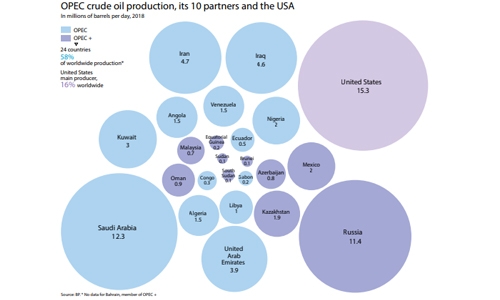OPEC deal won’t alter oil market outlook, says IEA
The recent decision by oil producing countries to prolong cuts in output will not fundamentally change the outlook for a market that is heavily oversupplied, the IEA said yesterday. “The widely-anticipated decision by OPEC+ ministers to extend their output agreement to March 2020 provides guidance but it does not change the fundamental outlook of an oversupplied market,” the International Energy Agency said in its latest monthly report.
At a meeting two weeks ago in Vienna, OPEC countries and other oil producers such as Russia agreed to prolong by nine months daily output cuts aimed at supporting prices and soaking up excess supplies. But supply is currently well in excess of demand, said the Paris-based institution that provides advice to oil-consuming nations. “The main message of this report is that in the first half of 2019, oil supply has exceeded demand by 0.9 million barrels per day,” the IEA said.
According to the agency’s latest data, there was a global surplus in the second quarter of 0.5 million barrels per day, compared to previous expectations of a deficit of about the same amount. “This surplus adds to the huge stock builds seen in the second half of 2018 when oil production surged just as demand growth started to falter. Clearly, market tightness is not an issue for the time being and any re-balancing seems to have moved further into the future,” the IEA said.
Assuming constant OPEC output at the current level of around 30 million barrels per day, “by the end of the first quarter of 2020, stocks could increase by a net 136 million barrels,” the IEA said. At the same time, the demand on OPEC crude in early 2020 could fall to only 28 million barrels per day. “Clearly, this presents a major challenge to those who have taken on the task of market management,” the report said. “The picture will evolve as 2019 progresses, but in the near term the main area of focus remains demand growth.”
The IEA said that it was sticking for the time being to its current forecasts for economic growth, but “there are indications of deteriorating trade and manufacturing activity.” Any slowdown in global economic growth will put the brakes on demand for oil. Recent data showed that global manufacturing output in the second quarter of 2019 fell for the first time since late 2012 and new orders have declined at a fast pace, the IEA said.
“On the positive side, the mood surrounding the US/China trade dispute appears to have improved and the resolution of outstanding issues would be a massive boost to economic confidence,” the report said.
Related Posts

